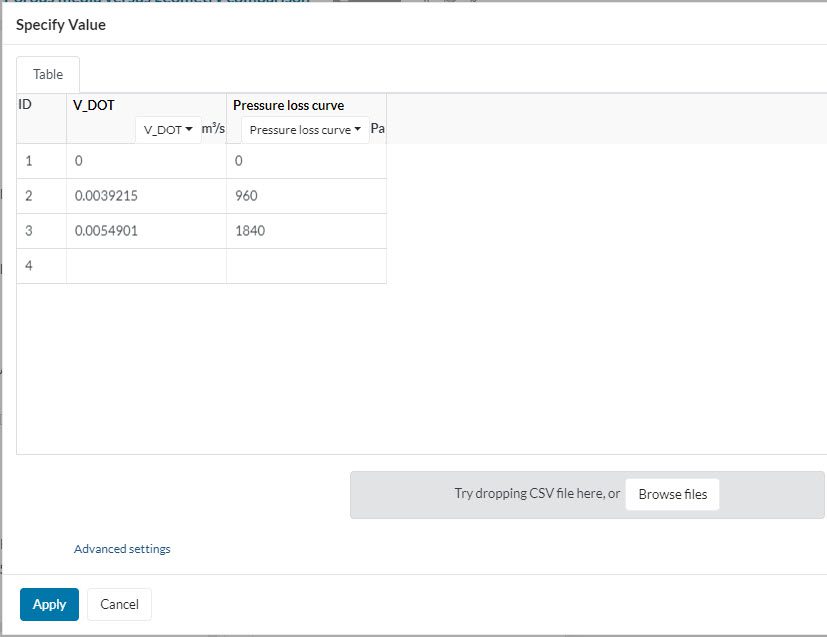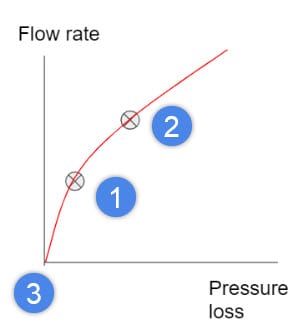Documentation
Porous media is a bidirectional concept. Whether it is isotropic (3D) or 1D, bidirectional means the flow can pass through opposite directions.
A medium or a material that has voids or pores or is filled with solid particles which let fluid pass through is called a porous medium.
Consolidated medium: The solid body has internal pores. Fluid passes through the pores.
Unconsolidated medium: A pile of solid particles is packed inside a bed. Fluid flows around the particles.
Using porous media simplification reduces CAD and mesh complexity, and saves computational time and expenses.
With the porous media feature, users can define porosity characteristics of volumes within the computational domain. Defining these porosity characteristics increases the accuracy of certain simulations. SimScale allows its users to model a porous entity inside the simulation domain in five different ways.
A porous media can be created under the Advanced Concepts tab in the simulation tree. The following models are available:
This porosity model takes non-linear effects into account by adding inertial terms to the pressure-flux equation. The model requires both Darcy \(d\) and Forchheimer \(f\) coefficients to be supplied by the user. If the coefficient f is set to zero, the model degenerates into the Darcy equation.
Furthermore, two-unit vectors for a local coordinate system have to be specified. A third vector is implicitly defined, such that (\(\vec{e_1} \vec{e_2} \vec{e_3}\)) is a right-handed coordinate system like (x y z). These three vectors should be the main directions of the porous zone resistance. Please note that the \(d\) and \(f\) coefficients are prescribed for each direction separately. It can be used for both anisotropic and isotropic medium.
The model leads to the following source term for the momentum equation:
$$S = – (\mu d + \frac{\rho |U|}{2} f) U$$
Where:
The Darcy coefficient is the reciprocal of the permeability κ.
$$d = \frac{1}{\kappa}$$
For an example on how to apply the Darcy-Forchheimer model, please check this page.
This model requires \(\alpha\) and \(\beta\) to be supplied by the user. The corresponding source term is:
$$S = – \rho_{ref} (\alpha + \beta |U|) U$$
Where:
Similarly to the Darcy-Forchheimer model, the user has to specify two unit vectors for a local coordinate system. The \(\alpha\) and \(\beta\) coefficients are input based separately for each direction. Therefore, a fixed coefficients medium can be used to define isotropic and non-isotropic porosity.
Once the setup is complete, a porous region must be assigned. Such a region can be defined using geometry primitives or cell zones.
Important
Fixed coefficients, alongside with the pressure loss curve model, are the only two that can be used for compressible, convective heat transfer, and incompressible cases.
The Darcy-Forchheimer, Power Law, and Perforated Plate models should only be used for incompressible and convective heat transfer (with compressibility disabled).
In the power law formulation, the source term for the momentum equation is given by:
$$S = – \rho C_0 |U|^{(C_1)}$$
Where:
Note that a power law media will always be isotropic. Cell zones and geometry primitives can be used to assign a power law porous media.
For an example on how to apply the power law model, please check this page.
The pressure loss curve is a simplified version of the Darcy-Forchheimer model. As input, the user has to provide the following information:

Important
These inputs define the length of the porous media which was used to generate the curve and its cross-sectional area (normal to flow). They refer to the experimental model’s dimensions, and not to the CAD part that is being used to model the porous media.
Based on the input, a polynomial curve fit is performed and the Darcy-Forchheimer coefficients are automatically calculated. Therefore, the pressure loss curve formulation is a more convenient way of using the Darcy-Forchheimer model.
Important
Curve fitting methods work when a total of three or more data points are provided (including the first [0, 0] point). However, oftentimes, users only have a single non-zero data point for volumetric flux versus \(\Delta P\).
In case a single data point is available for your geometry, the approach described below can be used. This approximation is especially good for turbulent flow, providing satisfactory agreement:
1. Following the Darcy-Forchheimer model, assume that the Darcy coefficient is zero. Therefore, only the inertial term (Forchheimer) is considered;
2. Calculate f. Rearranging the Darcy-Forchheimer formulation, we have:
$$f = \frac {2\Delta P}{\rho U^2}$$
3. Extrapolate another data point, by choosing a different velocity (e.g. 2 times greater than the velocity from the first data point) and calculating the corresponding \(\Delta P\):
$$\Delta P = \frac {f\rho U^2}{2}$$
4. Calculate the corresponding flow rate for the velocity chosen in step 3;
5. The picture below shows the resulting three points. [1] represents the initial data point. [2] is the point that is predicted and [3] is the (0, 0) data point;

6. Input the data points in the table, keeping in mind that the first point should be (0, 0).
7. The table values should have a consistently increasing trend from (0,0) to the maximum point. In addition, the table values should not be repeated.
The perforated plate model estimates pressure loss based on geometrical parameters. As inputs, the user has to provide:
The perforated plate model is based on the formulation presented in [1].
Important
For all porous media models, it’s important to refine the region around the porous media appropriately.
Make sure at least 5 mesh cells are placed across the porous media thickness.
The pressure loss function porous media is exclusive to the multi-purpose solver. Similarly to the pressure loss curve model, the user defines a volumetric flow rate versus delta pressure table by clicking on the table button:
At least 3 data points are recommended for the table definition, with the first one being 0 flow rate and 0 pressure drop. With more points a better interpolation is obtained.
Note that this porous media model is always isotropic and the volume assignment needs to be done to a CAD volume, since geometry primitives are not supported.
The Darcy Law medium is another porous media model exclusive to the multi-purpose solver. With the current implementation, this porous media model is always isotropic.
The Darcy Law medium in SimScale is based on the following formulation:
$$ dP = \frac{\mu L U}{K} + \frac{C_d \rho L U^2}{\sqrt{K}} $$
Where:
When inspecting the formulation that is used for the Darcy Law medium model, when the drag coefficient \(C_d\) term is not zero, both Darcy (linear) and Forchheimer (quadratic) terms will be present. This is usually the case for applications involving larger velocities since the quadratic term becomes more relevant as velocity increases.
On the other hand, when \(C_d\) is zero, this model is purely based on Darcy’s law.
References
Last updated: October 22nd, 2024
We appreciate and value your feedback.
What's Next
Power Sourcepart of: Advanced Concepts
Sign up for SimScale
and start simulating now